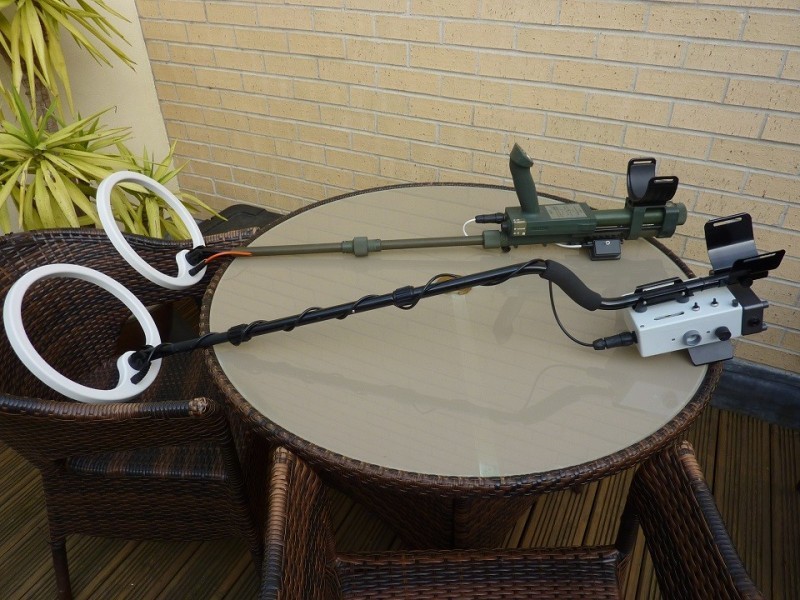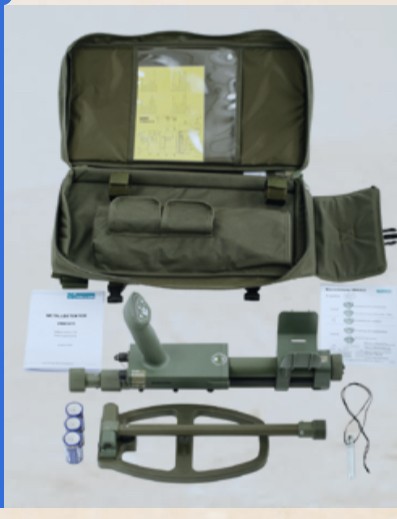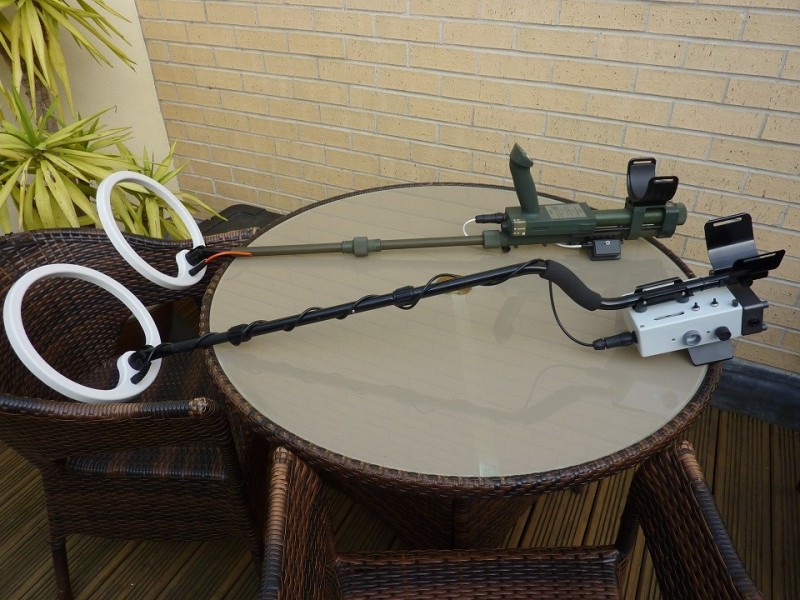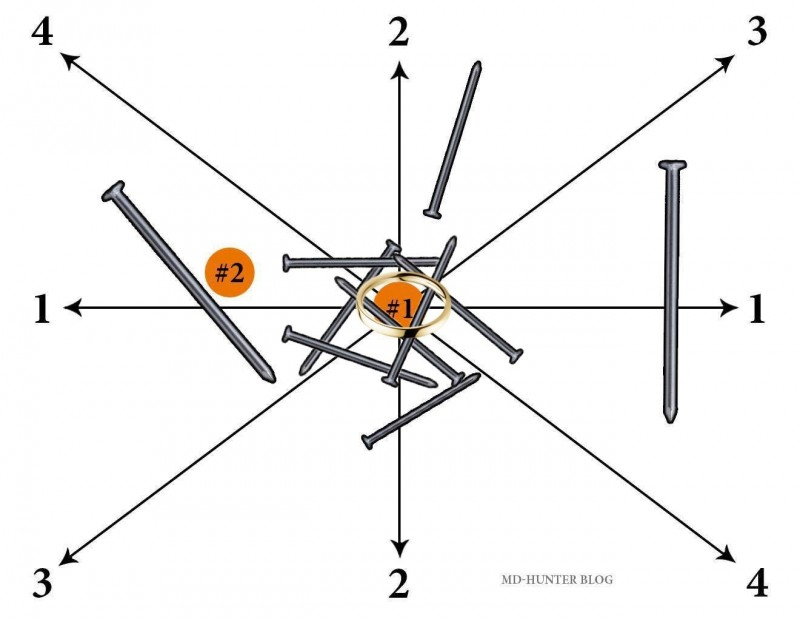-
Posts
1,072 -
Joined
-
Last visited
Content Type
Forums
Detector Prospector Home
Detector Database
Downloads
Everything posted by Rick K - First Member
-

Elusive Diablo Micromax
Rick K - First Member replied to Rick K - First Member's topic in Compass, Tesoro, Troy, Etc.
Yes, that’s the coil, but I’m looking for a used one at a better price! There was a smaller elliptical coil as well, presumably even more sensitive to tiny gold, but they are rare. -

Elusive Diablo Micromax
Rick K - First Member replied to Rick K - First Member's topic in Compass, Tesoro, Troy, Etc.
I believe it takes any of the 4 pin coils, the standard one is the 10” elliptical concentric Here’s a link to the original sales flyer and another link to an old Tesoro catalog https://static.secure.website/wscfus/6268851/8332007/tesoro-diablo-umax.pdf https://static.secure.website/wscfus/6268851/uploads/Tesoro_Catalog_13.pdf A quick solution to my problem might be to buy a Lobo Super Trac that someone in our club has on offer for less than I paid for the coilless Diablo - same coil and just swap machines. -
One popped up on eBay just now - couldn’t resist - Buy it Now - I did No coil. If I understand correctly it takes standard 4 pin coils for the Lobo super trac and similar. Have to figure out what coil to get for it. This will be my third one - Probably made enough off the first two to pay for it - but out of respect for Dave Johnson - who designed it and pronounced it to be his favorite design - I guess I’ll keep this one. Rick Kempf Gold Canyon AZ- where there is no gold
-
I posted this last month on an old thread in the Metal Detector Advice about the Vallon mine detectors. The consensus was that as nugget hunters they might not be so great. While I have no data on that, I suspect that they might be pretty good except on extreme OZ ground - probably equal to or Better than a TDI. As a beach machine however, they present a really interesting possibility. I have now checked out the 2 I bought on eBay from Poland and they both work fine. Here’s what I posted, followed by a bit of an update....They are a good bit lighter than an ATX - about like a TDI. 3 D cells, but you can use AA to D adapters and lighten that up - the power consumption is quite low and so that works, but get the ones which take 2 AA’s pr adapter so you can use 4 or 5 for longer run time, the machine runs on 3 - 4.5 volts - pretty remarkable engineering for a PI. Blast from the past on this 2 year old thread. I just ordered two of them from Poland. I took the plunge after tracking the ongoing (67 pages now) thread on Geotec. The thread was started by Eric Foster - noted PI detector designer - and is clearly showing that the Vallon VHM3CS is a very capable and interesting beach and relic machine - and may be useful for native gold as well. http://www.geotech1.com/forums/showthread.php?23169-Vallon-VMH3CS-Mine-Detector - the pics below are from Eric. The top ones shows a transformer box for conventional headset - see below. So, now I have them, I have done some simple functional checks. They detect a nickel buried in a wash here in AZ 13” down - about what a TDI will do. The interesting news is the the Vallon agent in the US will update the software to the latest version - free. If the units are sent postpaid both ways! So $199 on eBay, $67 shipping, and you have a useful non-discriminating beach PI for under $300. They come with the case which is really nice, heavy-duty canvas with shoulder straps and a “one-ear” headset. The headset connector is a milspec item but the wiring diagram is published and the mating plug is $8 surplus online - Piezo phones only unless you build a transformer in the circuit. https://www.ebay.com/itm/Army-metal-detector-VALLON-VMH3CS-Working-condition-BROKEN-ARMREST/282998790673?hash=item41e40ada11%3Ag%3AOqoAAOSwAnhbGTdX&LH_BIN=1
-
There have been reports where folks claim that the revised software is less deep than the original. Hard to say unless you have data on hand from a few of each version. It is a PI detector and sensitivity to tiny low conductor targets will likely be less than the Nox. Depth, of course is not the reason we use PP’s, it’s sensitivity to find exactly where a target is which has been previously detected - either to avoid a large hole or to find some tiny bit in a pile of excavated dirt.
-
I agree that the recent stuff on multi IQ has been much more informative. But the whole 28 frequency malarkey went on far too long - for decades I think. Of course it started in a time when the “magic” of metal detectors was very much what was selling them to the hopeful, but about the same time Whites was publishing their engineering white papers on their new units. It’s not partisan - just pointing out that folks who want to actually know what is going on - and who recognize the need to protect proprietary information - have historically had a very hard time getting decent technical information on which to base their purchasing decisions.
-
Folks focus on the details of the number of frequencies exactly because Minelab has been letting their marketing department write stuff which sounded like technical detail - but wasn’t - . Lots of blame to go around in the metal detector industry, but the confusion didn’t just “happen”. Hopefully public discussion like this will encourage manufacturers to stop telling marketing fairytales and making them sound like technical data.
-

Relic Hunting With GPX And Equinox
Rick K - First Member replied to Steve Herschbach's topic in Minelab Metal Detectors
No doubt that PI offers superior depth in mineralized ground to VLF, even multifreakers. Since Paul Palamo has (he tells me) given up on the forums altogether, I feel OK to share something he wrote to me last month. “As I mentioned earlier, still use top end Pulse Induction for my detecting needs both land and water. Everything else are toys, Inland or fresh water black sand mineralization is tougher than west coast black sand. That’s all I use now the GPX 5000 for relic hunting, and a good pi or Minelab for ocean.“- 9 replies
-
- 2
-

-
- minelab equinox
- minelab gpx
-
(and 1 more)
Tagged with:
-
I belong to a club in Phoenix which was founded in 1970 or 1971, Our meetings draw about 40 members on average. Club hunts about the same or a bit less. I doubt that more than 20% of our members know how many frequencies or what frequencies their detectors use. Likewise I doubt that more than 10% of them replace their machines in any given year. The total market for high end hobbiest detectors is really pretty limited and I seriously doubt that any company can survive selling only to that market. Minelab saw the writing on the wall for multi-thousand dollar pricing for high end machines - anybody who wants to charge significantly more than $1000 for a hobby metal detector has to offer something really special. Right now it is hard to see what that would be for even dedicated hobbiest. Current technology, including simultaneous multifreaker machines, offer nothing totally new in field performance. The Equinox hit the sweet spot - offering general detecting performance along with respectable salt beach and nugget hunting capabilities. That makes it very appealing at the price. I believe that “table stakes” for >$500 detectors now includes water resistance, ability to use wireless phones, and high residence to EMI. >$1000 price levels probably need to add multiple frequencies and respectable salt beach performance - which in turn means likely multi freq at the same time - either simultaneous or sequential. If you want to charge >$1500 you need even more. Advanced technology to make a real change in field performance. I’m thinking of changes like significantly superior unmasking - more than mere adjacent target separation - but actually defeating “silent masking” where a tiny bit of ferrous can mask a deeper nonferrous target. Also looking for greater depth in bad ground without losing ID capability at depth. Salt beach machines have shown no real improvement since the introduction of multifreakers like the CZ, BBS/FBS machines of decades ago. When you consider that Minelab can charge more than $6k for a nugget detector and you consider that a good season at the beach will likely bring in more gold than your average nugget hunter will see in many seasons, there is still a market for >$2000 salt beach machines which offer increased depth, small target sensitivity and usable iron ID - on any beach - including ones which look like this - which kill the depth on all current VLF detectors including current multifreakers.
-

Has Peak Gold Been Seen?
Rick K - First Member replied to mn90403's topic in Detector Prospector Forum
Mining is huge here in AZ. Saw a bumper sticker a few years ago... EARTH FIRST... WE’LL MINE THE PLANETS LATER -

Has Peak Gold Been Seen?
Rick K - First Member replied to mn90403's topic in Detector Prospector Forum
Peak oil turned out to be a bad call - fracking ended all that talk. There’s plenty of gold - just a question of cost of production vs. price of gold. -

Vallon Metal Detectors
Rick K - First Member replied to Shelton's topic in Metal Detector Advice & Comparisons
Blast from the past on this 2 year old thread. I just ordered two of them from Poland. I took the plunge after tracking the ongoing (67 pages now) thread on Geotec. The thread was started by Eric Foster - noted PI detector designer - and is clearly showing that the Vallon VHM3CS is a very capable and interesting beach and relic machine - and may be useful for native gold as well. http://www.geotech1.com/forums/showthread.php?23169-Vallon-VMH3CS-Mine-Detector -

Can Your Detector Do This?
Rick K - First Member replied to Rick K - First Member's topic in Metal Detecting For Jewelry
In the actual test the ring was laying in a monks the nails and head in fact one nail crossed above it. Then the board with the nails was lifted up a little hole dug in the sand the ring put into the holes and covered it up nail board put back it wasn’t deep an inch or two same result In due course I’m sure a lot of videos showing stuff like this will emerge – but as of now I’ve only seen the one video which I don’t have permission to share -

Can Your Detector Do This?
Rick K - First Member replied to Rick K - First Member's topic in Metal Detecting For Jewelry
No “aged nail” tests have been done as far as I know. The same set up has been done with the card on the ground with the nails - and the ring under the card in the sand to a depth of a few inches at least. Further fun will have to await the introduction of a production machine sometime next year (hopefully). then everybody can decide if this a revolution or a parlor trick. Me - I”m saving my money for the “Beach Beast”. -
The detector Tom introduced in his post is apparently different in its function than any other detector on the market. There is reason to believe that it may be the work of Diimitar Gargov who formerly worked at Fisher in CA and then went to El Paso for a while after FT acquired the ”remains” of the “old” Fisher. No one has posted any info on what sort of signal generation system and target analysis it uses. Also unknown is where and by whom it will be manufactured.
-
Free trade causes disruption of national economies - local high cost production has to change or disappear when world-scale producers have access to the local market. First Texas creates lots of good jobs in El Paso because they can export container loads of metal detectors to Europe, Asia Africa and the rest of the world. They also create jobs in Mexico because one or more facilities that they operate there do detail fabrication of components which go to El Paso for incorporation into the detectors produced in El Paso. This is exactly the same process used by many US and international companies to produce components and sub assemblies in Mexico - very often using US sourced components - which are then imported to the US for incorporation into US products. I have no specific information on advanced technology being developed by any detector maker, including First Texas. I am quite sure however that they are willing to spend money and engineering manhours on new products, I’m sure that they are aware that current detector technology is vulnerable to a breakthrough. It has been essentilly “stuck” for a couple of decades.
-

Can Your Detector Do This?
Rick K - First Member replied to Rick K - First Member's topic in Metal Detecting For Jewelry
Easy test to do if you have the machine. I don‘t have one. I need to try my Vista Gold Gain with the 6” -
Detector put into iron silent mode - swept over nails - Nails ignored - ring added - still in iron silent mode - ring detected with proper tone - ring removed -nails ignored again. Also works with ring buried couple of inches under the board with the nails. I know it’s just a drawing, but I’ve seen it done for real. How about you? P.S. ignore the numbers and the reference to the md-detector website, that’s just where the original graphic - without the added central nails and the ring came from. the finished graphic is the original nail board diagram plus the nails in the center and ring which were added in the actual testing.
-
Dubious - I couldn’t agree more - all those nice rust belt manufacturers who fired their workers - offshore their production (not to mention the online customer service) and didn’t lower the sales price a penny - pocketing profits stolen from the tables of their employees. The other story is a bit different. New enterprises, investing their own NEW money in innovation, design, distribution, customer service and making competively prices produced here - or overseas while building a business. Lots of them are seeing benefit in high quality production in North America. Notice the Japanese and German car makers opening plants in the US. My little sermon (sorry if it sounded like that) about FT was precisely because all those good jobs wouldn’t exist in El Paso if some Americans hadn’t used their brains and money to figure out how to make the best of the unique situation represented by the Rio Grande. Our new nation had to fight another war with Great Britain in 1812 over the right to engage in international trade. times change - we must adapt.
-
On second thought..... Flowery Retoric? An engineer and a literary critic. I wrote that stuff, not First Texas, not some spin doctor - I stand behind what I wrote. A plain description of what I believe the facts to be. If I got a bit carried away about El Paso - go spend some time there - it’s really unique. I guess your experiences have left you skeptical that well managed subcontracting can be of benefit to the firm as well as their customers. The difference here is that the Mexican facility which does board work is First Texas’ own factory. It is run by them and works to their own standards. Sorry that the folks you worked for subcontracted out carelessly. I spent 30 years in sourcing - purchasing and sub contracting. It can be done well, but it takes work and care. Lots of plants in Mexico turn out quality work. Sorry your subcontractor’s one turned out crap. The real difference between your story and mine - If I read yours correctly - was that the management of where you worked saw an opportunity to keep pumping out their current products at much lower cost - by replacing local labor with foreign labor. What happened at FT was quite different. New US initiative resurrected three moribund US brands, put folks to work in El Paso - engineers, marketing folks, administrative staff, line workers. they could do that because the costs saved by having part of the process done with lower priced labor in Mexico meant that the whole thing could be profitable and grow - employing more folks in El Paso. I hope this wasn’t too “flowery”.
-
I have been to visit FT in El Paso a few times now. Once in their new facility - it’s huge! The first time I went there - mostly to see Dave Johnson and Carl Moreland who I had know by correspondence for several years, I got introduced to Tom Walsh, the CEO. I had heard that when things got bad in the Great Recession, he had to lay off the less than full time folks and felt bad about it. The senior staff took a big pay cut. Tom eliminated his salary altogether (of course, it’s a closely held corporation and so he has ownership interests). Anyway, one of the Marketing guys took me around and introduced me to office and “touch labor” staff as we went around. The following bit is entirely true...Out of the dozen or so folks I was introduced to at least 3-4 of them asked me “have you met Tom?” When I answered yes - every one of them said exactly the same thing - “He’s a wonderful man”. I have worked for a half-dozen corporations in my life. I can’t remember ever hearing one of my fellow employees characterize the CEO as “a wonderful man”. El Paso is a large city now, but in many ways, still a village. A border town - two cultures, two histories, two languages - deeply and mostly happily intertwined. FT is the result of Tom and some other folks getting involved in electronic component production via the “maquiladora” business. US/Mexican trade regulations which made it possible for US companies to set up wholly owned operations in Mexico within X miles of the US border. These operations could import raw material, semi finished products, etc. - add value through processing or assembly and then export/re-import to the US free of Mexican and US customs duty. At some point Tom figured it that Metal detectors were a sort of medium tech product that could be produced in quantity at low cost by combining the stability and quality control of an El Paso facility with the low cost of board stuffing and other touch labor operations south of the border. He acquired some brands - bounty hunter and Teknetics, hired Dave Johnson and others, then acquired the nearly (or completely) bankrupt Fisher. He also hired some very savvy marketing guys who realized that to sell at volume, they would have to build on more than the classic distributor/dealer arrangements in the industry - at least in the US. A lot of what they do and why has to do with their particular approach to the domestic market here and their different approach to the market in the rest of the world. The other effect of the maquiladora program was to attract electronic talent to ElPaso. Now automotive and aerospace companies design and produce lots of high to medium tech stuff in a cross-border way. The Univ of Texas at ElPaso - UTEP hs a strong electrical engineering department as does the Instituto Technologico de Chihuahua in Chihuahua City - the nearby capitol of that Mexican state. Anyway - don’t count them out. Their engineering staff is solid and with the acquisition of the Manta project and the hiring of the “Euroteam” that developed it - they have leapfrogged dozens of man-years of R&D on not only PI detectors but advanced concepts for mixed mode and AI driven detection approaches. But at the end of the day, it’s a small business, like all detector companies. Investment funds and staff time is not unlimited and sometimes things move at a pace which shows those limits.
-
Single frequency at every price point and capability was done decades ago. Now the price points are coming down because of competition. Waterproof is a new selling point, but in more than 30 years of detecting, I have only needed it at the beach and then either multifreak or PI are needed as well. New tech is coming along, but frankly nothing really new has emerged. More than one frequency at a time from one detector - ML did that a decade ago. Multifreak at the same time - ML. Fisher and Whites did that decades ago. Light multifreaker waterproof - nice combination - now done by ML. Something which works deeper than currently available with good ID at depth - waiting. Something which defeats “silent masking” of even tiny ferrous preventing detection of deeper non ferrous - still waiting. there’s lots of room for improvement, but the ugly reality of enormously variable ground and enormously variable target returns mean millions still need to be spent to try and make improvements come to market. We will see who can manage it for the relatively tiny market our hobby represents compared to the investment required. Who wants to guess how much money is spent every year on metal detectors (excluding gold nugget hinting) which cost more than $300. My guess - way less than on fidget spinners.









